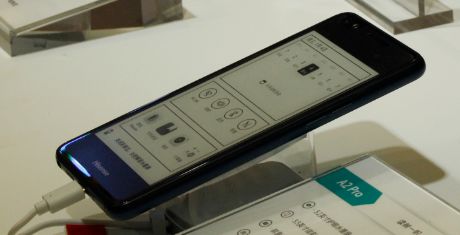
As the importance of screens in electronic products increases, companies are investing more in display technology. Currently, the three most promising screen technologies are PMOLED, OLED, and AMOLED. Taking smartphones as an example, the mainstream display device is still liquid crystal panels, but the new AMOLED technology has already been used in many high-end smartphones. Many industry insiders believe it will become the mainstream display technology in the coming years. What are the characteristics of OLED, and what are the connections and differences between PMOLED and AMOLED? What are their advantages? This article will explain each in detail.
The Two Major Branches of OLED Technology: PMOLED and AMOLED

The characteristics of OLED displays include self-lighting, high contrast, low power consumption, light weight, and thinness. It is known as the next-generation display technology. Based on the driving method, OLED can be divided into active drive (AMOLED) and passive drive (PMOLED).
AMOLED features a TFT (thin-film transistor) with a switch for each pixel, making it easier to achieve high brightness, high resolution, high color performance, and low energy consumption. This type of panel is widely used in consumer electronics. PMOLED has a simple structure and easy manufacturing process, effectively reducing manufacturing costs and achieving very fast response times. However, PMOLED faces issues of high power consumption and reduced lifespan, with product sizes limited to about 5 inches.
Connections, Differences, and Advantages of PMOLED and AMOLED
Both PMOLED and AMOLED belong to OLED technology, with the difference being in their driving methods. PMOLED is also known as passive matrix organic light-emitting diode, and its light-emitting principle is similar to that of STN LCD, while AMOLED is known as active matrix organic light-emitting diode, akin to TFT LCD.
PMOLED simply consists of a matrix made up of cathodes and anodes, lighting up the pixels in the array via scanning. Each pixel operates in a short pulse mode for instant high brightness. Its advantages include a simple structure and effective cost reduction, but the high driving voltage makes PMOLED unsuitable for large and high-resolution panels, which is contrary to current development trends.
AMOLED uses independent thin-film transistors to control each pixel, allowing each pixel to be continuously and independently driven to emit light. It can use low-temperature polysilicon or oxide TFT for driving, with advantages of low driving voltage and long lifespan of the light-emitting components. However, the high cost and complex manufacturing processes make it harder to control costs.
PMOLED is not suitable for displaying dynamic images due to its relatively slow response time, but it is very energy-efficient; AMOLED features fast response times and can be used for large TV panels, but it has the drawback of high power consumption.
Connections and Differences Between AMOLED and OLED

Although LEDs are also common in daily life, each LED in a screen is very small and divided into red, green, and blue sub-pixel groups, forming different colors. The arrangement of sub-pixels also affects the overall display effect. The ‘O’ in AMOLED stands for Organic, meaning that a series of organic thin-film materials are used between the positive and negative electrodes to achieve light emission. AM stands for Active Matrix, which is in contrast to Passive Matrix, referring to the driving method of each OLED pixel.
In Passive Matrix, the control of each pixel is achieved through a complex electrode network, allowing for the charging and discharging of a specific pixel. Overall, the control method of Passive Matrix is relatively slow and has lower control precision. In contrast, Active Matrix adds TFT and capacitor layers to each LED, so that when a specific row and column are powered to activate the intersecting pixel, the capacitor layer within the pixel can maintain a charged state between refreshes, enabling faster and more precise control of pixel light emission.
OLED is also known as organic electroluminescent display or organic light-emitting semiconductor, differing from liquid crystal displays in terms of light-emitting principles. The main advantages of OLED screens are the high controllability of pixels, allowing each pixel to be independently switched on and off, achieving purer blacks and higher contrast. Additionally, turning off unnecessary pixels while displaying images can reduce power consumption; due to fewer internal layers in the screen module, the light transmittance is better, facilitating higher brightness and wider viewing angles.
OLED screens can be made very thin, making them very suitable for mobile devices like smartphones. With the absence of a hard backlight layer and the maturity of flexible plastic substrates, OLED also has significant advantages in flexible screens, creating more possibilities for the shapes of future mobile devices and even wearable devices.
AMOLED is a type of OLED, but the reverse is not true. In simple terms, OLED technology includes both PMOLED and AMOLED. PMOLED does not require a TFT backplane but cannot be made very large; AMOLED can be made very large. PMOLED was primarily found in early dual-screen phones for small external displays, while current smartphones and televisions use AMOLED technology.
AMOLED is an active organic light-emitting diode, which requires not only a signal but also an additional point source to achieve operational status. It receives signals to light up or turn off, much like a television that requires a cable signal to view content; without power, it cannot display anything, and without a cable signal, there is no program to watch.
Structurally, OLED is essentially a diode, while AMOLED can be thought of as a triode or multiple transistors driving a single light-emitting point.
Connections and Differences Between PMOLED and OLED
PMOLED stands for passive matrix OLED, which relates to the way the display is controlled (or driven). PMOLED displays use a simple control scheme where each row in the display is controlled sequentially. PMOLED electronic products do not contain storage capacitors; therefore, the pixels in each row are mostly off. To compensate for this, more voltage is required to make them brighter.
The advantages of PMOLED are simpler processing and a straightforward structure, while the disadvantages include difficulties in scaling to larger sizes. To maintain the brightness of the entire panel, the brightness of each pixel must be increased, which raises the operating current and consequently reduces the lifespan of the OLED device, making current drive control challenging.
Challenges Facing AMOLED in Popularization
Compared to PMOLED, AMOLED has more obvious advantages, making it more practical and spreading faster, having developed into the mainstream OLED technology. It inherits the energy-saving, ultra-thin, and flexible characteristics of OLED materials, but its development is still not mature.
AMOLED industrialization faces three main issues: the unresolved lifespan problem of blue OLED light-emitting materials affects the overall lifespan of the display screens, color accuracy issues arise, and cost disadvantages are also current challenges.
Users have criticized AMOLED for its color reproduction not matching that of IPS screens, with displayed colors being overly vibrant and saturated, leading to poor color representation. Nevertheless, people remain optimistic about this technology.
Both OLED and AMOLED are considered the next generation of easily popularized display technologies. Companies like Samsung Electronics, Samsung SDI, LG, and Philips are paying great attention to this new display technology. Domestic companies such as Tianma Microelectronics, BOE, Visionox, Huaxing Optoelectronics, and Hongshi are also actively laying out their plans, indicating a bright future. With the involvement of domestic enterprises, the situation of “lack of chips and screens” in China may change.
Source: OFweek Electronics Engineering
Edited by: Shi Xiaoqi
